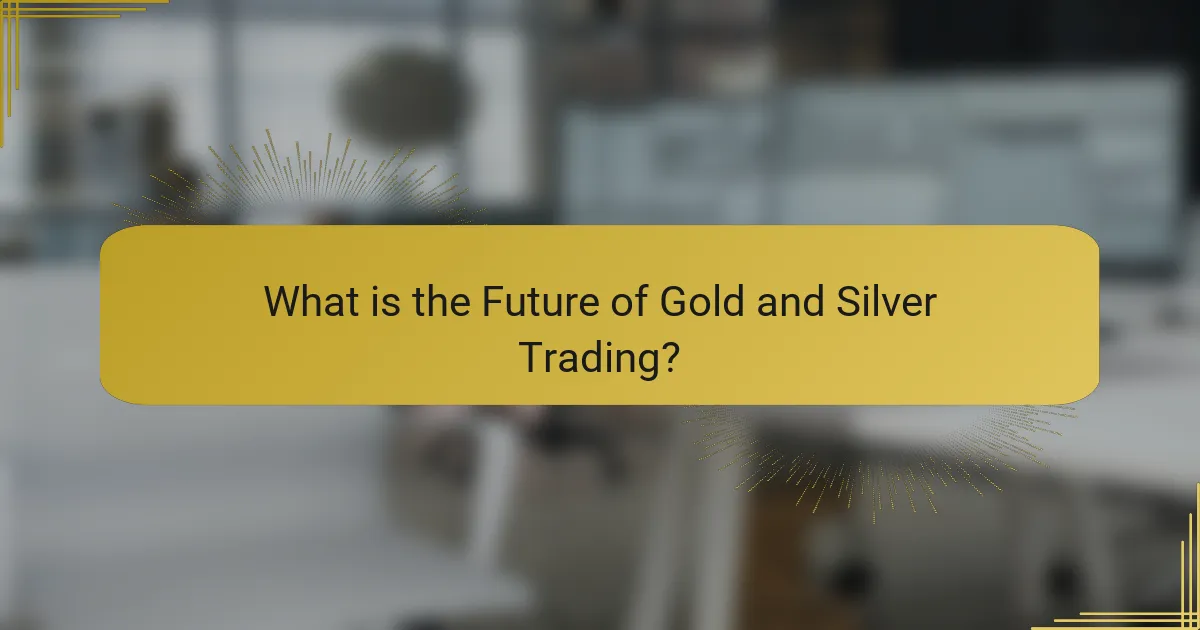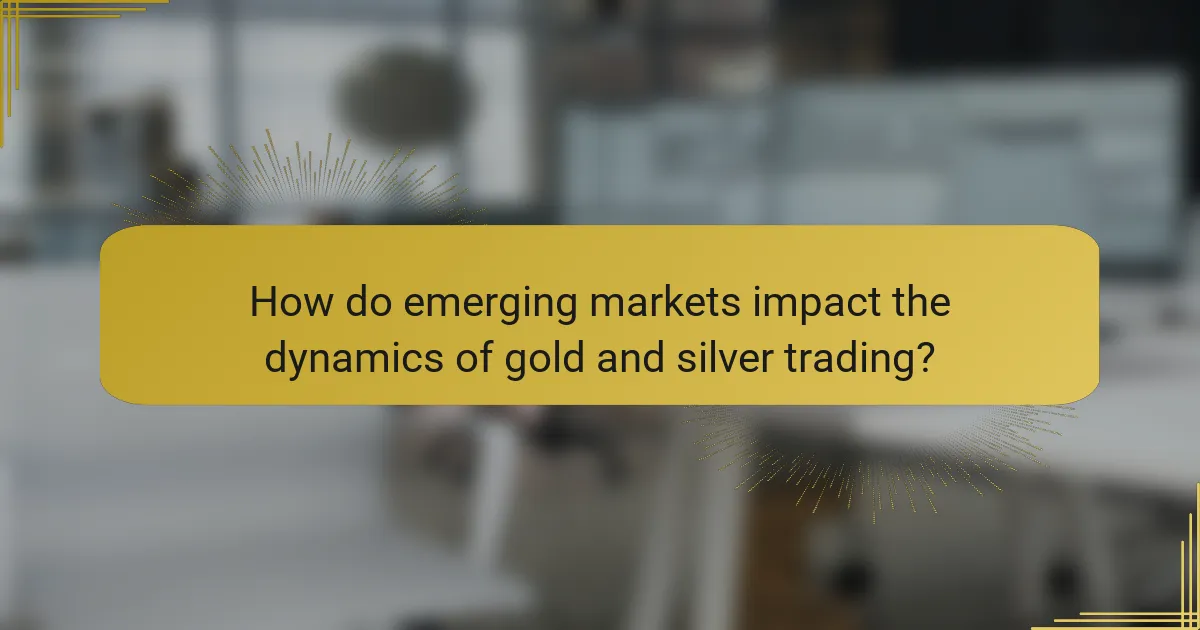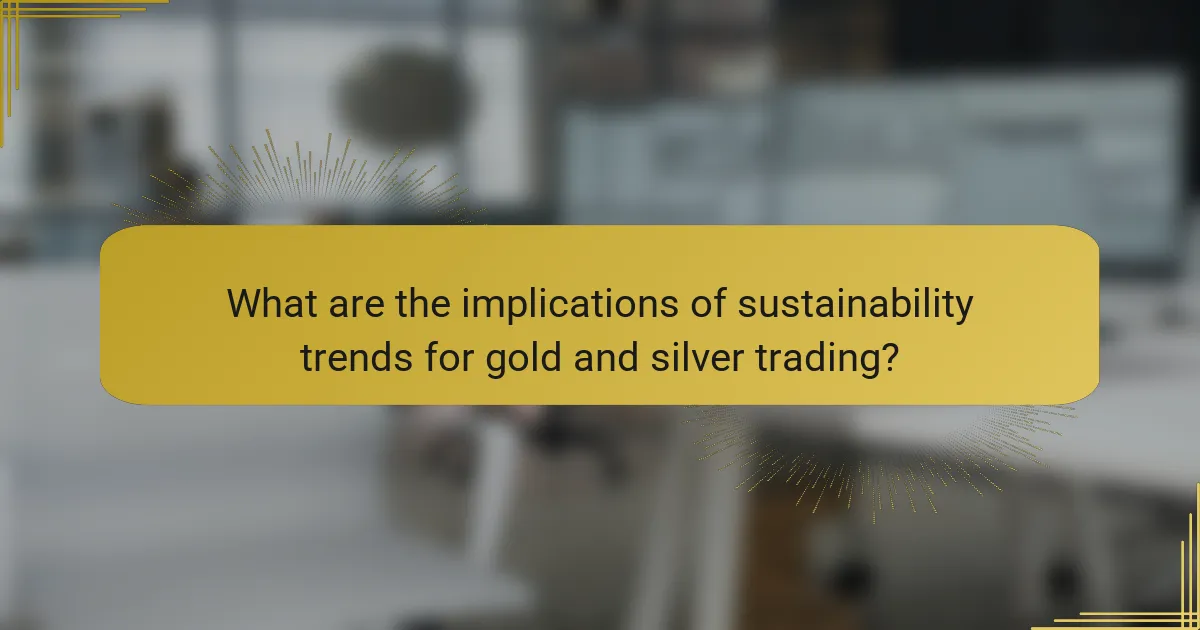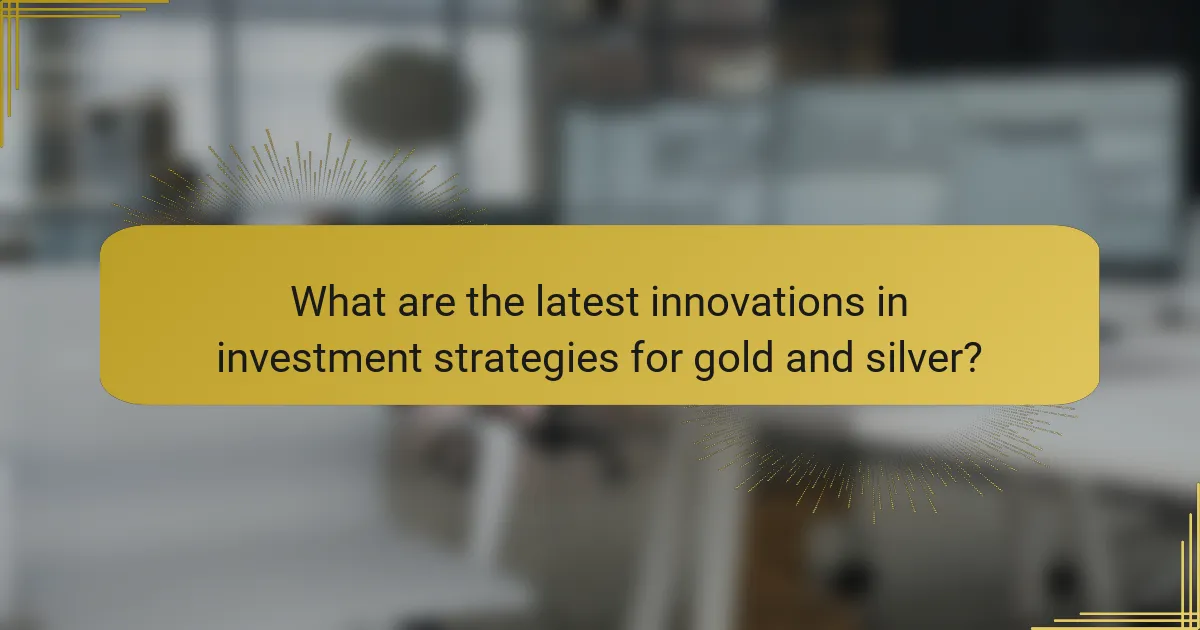The article focuses on the future of gold and silver trading, highlighting the influence of emerging markets, sustainability trends, and investment innovations. Increased demand from countries such as India and China is expected to drive prices higher, while technological advancements in trading platforms will improve accessibility and efficiency. The growing emphasis on sustainable investing will encourage the use of ethically sourced metals, reflecting a shift in consumer preferences and regulatory practices. Additionally, market volatility may rise due to geopolitical tensions and economic fluctuations, with historical data indicating that gold and silver often act as safe-haven assets during downturns. Overall, the evolving landscape of gold and silver trading is shaped by these interconnected factors.

What is the Future of Gold and Silver Trading?
The future of gold and silver trading is expected to be influenced by emerging markets and sustainability trends. Increased demand from countries like India and China will likely drive prices higher. Technological innovations in trading platforms will enhance accessibility and efficiency. Additionally, the growing interest in sustainable investing will promote the use of ethically sourced metals. Market volatility may also increase due to geopolitical tensions and economic fluctuations. Historical data indicates that gold and silver often serve as safe-haven assets during economic downturns. These factors combined suggest a dynamic and evolving landscape for gold and silver trading.
How are emerging markets influencing gold and silver trading?
Emerging markets significantly influence gold and silver trading by increasing demand and altering market dynamics. Countries like China and India are major consumers of gold and silver. Their growing middle class drives higher consumption rates. In 2022, China accounted for approximately 30% of global gold demand. India followed closely, representing around 25%.
Additionally, emerging markets often turn to gold and silver as safe-haven assets during economic uncertainty. For example, during inflationary periods, these markets tend to increase their investments in precious metals. This behavior impacts global prices and trading volumes.
Furthermore, the rise of digital platforms in emerging markets facilitates easier access to gold and silver trading. This accessibility encourages more investors to enter the market. Consequently, emerging markets are reshaping the landscape of gold and silver trading through increased demand and innovative trading methods.
What specific regions are becoming significant players in this market?
Asia and Africa are becoming significant players in the gold and silver trading market. Countries like China and India lead in demand for precious metals. China’s gold consumption reached over 1,000 tons in 2020. India follows closely, with a strong cultural affinity for gold. In Africa, nations like South Africa and Ghana are increasing their mining outputs. These regions are also adopting sustainable practices in mining. This shift is attracting global investors. The growth in these regions is reshaping the dynamics of the market.
How do economic conditions in these emerging markets affect trading?
Economic conditions in emerging markets significantly influence trading dynamics. Fluctuations in GDP growth impact investor confidence and market liquidity. For example, rapid economic growth can lead to increased demand for commodities like gold and silver. Conversely, economic downturns may result in reduced consumer spending and lower trading volumes. Currency stability also plays a crucial role. A strong local currency can enhance purchasing power, while currency depreciation may lead to increased costs for imported goods. Additionally, political stability affects trading environments. Countries with stable governments tend to attract more foreign investments, boosting trading activities. Conversely, political unrest can deter investment and disrupt trading operations. Overall, the economic landscape in emerging markets directly shapes trading opportunities and risks.
What sustainability trends are shaping the future of gold and silver trading?
Sustainability trends shaping gold and silver trading include ethical sourcing, increased recycling, and eco-friendly mining practices. Ethical sourcing ensures that metals are acquired without human rights violations or environmental damage. This trend is driven by consumer demand for responsibly sourced materials. Increased recycling of precious metals reduces the need for new mining operations. It also minimizes environmental impact and conserves resources. Eco-friendly mining practices focus on reducing carbon footprints and using sustainable technologies. According to the World Gold Council, sustainable mining practices are becoming a standard in the industry. These trends are essential for aligning with global sustainability goals and attracting environmentally conscious investors.
How is the demand for sustainable mining practices impacting the industry?
The demand for sustainable mining practices is reshaping the mining industry significantly. Companies are increasingly adopting eco-friendly technologies to reduce environmental impacts. This shift is driven by consumer preferences for responsibly sourced materials. Investors are also prioritizing sustainability in their portfolios. According to a survey by PwC, 79% of mining executives believe that sustainability is essential for long-term success. Regulatory pressures are intensifying, requiring companies to comply with stricter environmental standards. This trend is leading to increased operational costs but can enhance brand reputation. Overall, sustainable practices are becoming a competitive advantage in the mining sector.
What role do ethical sourcing and environmental regulations play?
Ethical sourcing and environmental regulations are critical in gold and silver trading. They ensure that mining practices do not harm local communities or ecosystems. Ethical sourcing promotes transparency in supply chains. It encourages companies to source materials from responsible producers. Environmental regulations limit pollution and resource depletion. They require companies to adhere to sustainable practices. Compliance with these regulations enhances brand reputation. It also attracts socially conscious investors. According to the World Gold Council, 75% of investors prioritize ethical sourcing in their decisions.
What investment innovations are transforming gold and silver trading?
Digital platforms and blockchain technology are transforming gold and silver trading. These innovations enable real-time trading and greater transparency. Blockchain provides a secure method for tracking ownership and provenance. This reduces fraud and increases trust among investors. Additionally, fractional ownership allows investors to buy smaller amounts of gold and silver. This lowers the barrier to entry for retail investors. Furthermore, exchange-traded funds (ETFs) have made precious metals more accessible. ETFs provide a way to invest in gold and silver without physical ownership. These innovations are reshaping the landscape of precious metals trading.
How are technology and digital platforms changing the trading landscape?
Technology and digital platforms are revolutionizing the trading landscape by enhancing accessibility and efficiency. They allow traders to execute transactions in real-time, which reduces latency. Automated trading algorithms analyze market data at high speeds, enabling better decision-making. Mobile trading applications provide users with trading capabilities from anywhere, increasing participation. Blockchain technology enhances transparency and security in transactions. Digital platforms also facilitate peer-to-peer trading, bypassing traditional intermediaries. According to a 2021 report by McKinsey, digital platforms have increased trading volumes by 50% in the last decade. These advancements are reshaping how traders interact with markets and each other.
What new financial products are emerging in the gold and silver markets?
New financial products in the gold and silver markets include exchange-traded funds (ETFs) focused on sustainability. These ETFs allow investors to gain exposure to precious metals while emphasizing environmentally responsible mining practices. Additionally, digital gold and silver platforms are emerging, enabling fractional ownership and easier transactions. Innovations like blockchain-backed gold certificates are also being introduced, providing secure and transparent ownership records. These developments reflect a growing trend towards integrating technology with traditional precious metal investment.

How do emerging markets impact the dynamics of gold and silver trading?
Emerging markets significantly influence gold and silver trading dynamics. These markets often experience rapid economic growth, increasing demand for precious metals. For instance, countries like India and China are major consumers of gold for jewelry and investment. Their rising middle class drives higher consumption rates. Additionally, these markets can affect global prices due to increased buying activity. In 2021, India accounted for 26% of global gold demand, showcasing its impact. Furthermore, geopolitical stability in emerging markets can lead to fluctuations in trading volumes. As these economies grow, they also diversify their investment portfolios, incorporating more gold and silver. This diversification can create volatility in the market. Overall, emerging markets play a crucial role in shaping the trends and pricing of gold and silver trading globally.
What are the key factors driving growth in these markets?
The key factors driving growth in gold and silver trading markets include increasing demand from emerging economies, technological advancements, and sustainability trends. Emerging markets, particularly in Asia, show rising wealth and investment interest in precious metals. Technological advancements, such as blockchain and digital trading platforms, enhance accessibility and efficiency in trading. Sustainability trends also play a role, as consumers and investors increasingly favor ethically sourced metals. According to the World Gold Council, global gold demand reached 4,021 tons in 2022, driven by these factors.
How does population growth affect demand for gold and silver?
Population growth increases demand for gold and silver. More people typically lead to higher consumption of goods and services. Increased economic activity often drives demand for precious metals. Gold and silver are viewed as safe-haven assets during economic uncertainty. Historical data shows that demand for these metals rises with population increases. For instance, during periods of rapid population growth, such as in India and China, demand has surged. In 2020, global gold demand reached 4,021 tons, with significant contributions from populous nations. Thus, population growth directly correlates with the rising demand for gold and silver.
What economic indicators should investors monitor in emerging markets?
Investors should monitor GDP growth, inflation rates, and currency stability in emerging markets. GDP growth indicates the economic health and potential returns on investment. Inflation rates affect purchasing power and can signal economic instability. Currency stability reflects the reliability of investments in local currencies. Additionally, unemployment rates provide insight into labor market conditions. Trade balances indicate the relationship between imports and exports. Lastly, political stability can significantly influence economic performance. Monitoring these indicators helps investors make informed decisions in emerging markets.
What challenges do emerging markets face in gold and silver trading?
Emerging markets face several challenges in gold and silver trading. Limited access to global financial markets restricts their participation. Regulatory inconsistencies create uncertainty for investors. Infrastructure deficiencies hinder efficient trading processes. High transaction costs reduce profitability for traders. Currency volatility impacts the pricing of precious metals. Additionally, lack of transparency can lead to market manipulation. These factors collectively impede the growth and stability of gold and silver trading in emerging markets.
How do political instability and regulatory issues impact trading?
Political instability and regulatory issues significantly impact trading by creating uncertainty in the market. This uncertainty can lead to decreased investor confidence. For instance, during periods of political unrest, trading volumes often decline as investors become risk-averse. Regulatory changes can also disrupt trading practices, affecting liquidity and market access. In 2019, the U.S.-China trade war caused fluctuations in commodity prices, illustrating how regulatory issues can impact trading strategies. Furthermore, countries with unstable governments may experience increased volatility in their local currencies, further complicating trading decisions. Overall, political and regulatory factors play a critical role in shaping trading environments.
What are the risks associated with investing in these markets?
Investing in emerging markets for gold and silver trading carries several risks. Market volatility is a significant concern, as prices can fluctuate widely based on geopolitical events or economic changes. Regulatory risks also exist, as emerging markets may have unstable legal frameworks affecting investment security. Currency risk is another factor; exchange rate fluctuations can impact returns. Additionally, liquidity risk can arise, making it challenging to buy or sell assets quickly without affecting prices. Lastly, operational risks related to local infrastructure and management practices can hinder investment performance. Each of these risks can lead to potential losses for investors in these markets.

What are the implications of sustainability trends for gold and silver trading?
Sustainability trends significantly impact gold and silver trading by influencing market demand and regulatory practices. Increased consumer awareness drives demand for ethically sourced metals. Investors are prioritizing sustainability, leading to greater interest in responsible mining practices. Regulatory bodies are implementing stricter guidelines for environmental and social governance in mining. This shift encourages transparency in supply chains and promotes sustainable mining technologies. As a result, companies that adhere to sustainable practices may gain a competitive advantage. Research indicates that sustainably sourced gold and silver can command premium prices in the market. Thus, sustainability trends are reshaping the dynamics of trading in these precious metals.
How are companies adapting to consumer demand for sustainability?
Companies are adapting to consumer demand for sustainability by implementing eco-friendly practices. Many businesses are reducing their carbon footprints through renewable energy sources. They are also sourcing materials responsibly to minimize environmental impact. Companies are increasing transparency in their supply chains to build consumer trust. Additionally, brands are investing in sustainable packaging solutions to reduce waste. Research indicates that 66% of consumers are willing to pay more for sustainable brands. This trend drives companies to innovate in product development and marketing strategies focused on sustainability.
What practices are being adopted to ensure sustainable mining?
Sustainable mining practices include the implementation of eco-friendly technologies and responsible resource management. Companies are adopting practices such as reducing water usage and minimizing waste. They are also investing in renewable energy sources to power mining operations. Reclamation of mined land is a critical practice to restore ecosystems. Many organizations are enhancing transparency in supply chains to ensure ethical sourcing. Additionally, community engagement is prioritized to address local concerns. These practices are supported by global standards and certifications aimed at sustainability. The adoption of these practices is essential for reducing environmental impact and promoting social responsibility in the mining sector.
How do sustainability certifications influence market perception?
Sustainability certifications positively influence market perception by enhancing consumer trust. Products with recognized certifications are often viewed as more reliable and environmentally friendly. This perception can lead to increased sales and customer loyalty. Research indicates that 66% of consumers are willing to pay more for sustainable brands. Certifications signal a commitment to ethical practices, which attracts environmentally conscious consumers. Companies with sustainability certifications often experience improved brand reputation. This can differentiate them from competitors lacking such credentials. Overall, sustainability certifications play a crucial role in shaping consumer attitudes and purchasing decisions.
What are the financial implications of sustainability in trading?
Sustainability in trading has significant financial implications. It can lead to increased operational costs due to the adoption of environmentally friendly practices. Companies may invest in sustainable technologies, which require upfront capital. However, these investments can result in long-term savings and efficiency gains. Sustainable trading can also enhance brand reputation, attracting socially conscious investors. According to a 2021 report by McKinsey, companies focused on sustainability can outperform their peers financially. Additionally, regulatory pressures are increasing, and non-compliance can lead to financial penalties. Overall, sustainability in trading is a strategic financial consideration that can influence profitability and market positioning.
How can sustainable practices lead to long-term profitability?
Sustainable practices can lead to long-term profitability by reducing operational costs and enhancing brand loyalty. Companies that adopt eco-friendly methods often experience lower energy and resource expenses. For instance, a study by the Carbon Trust found that businesses implementing energy-efficient practices can save up to 20% on energy costs. Additionally, sustainable practices attract environmentally conscious consumers. A Nielsen report indicated that 66% of global consumers are willing to pay more for sustainable brands. This increased demand can drive higher sales and market share. Furthermore, sustainable businesses often benefit from tax incentives and grants. These financial advantages contribute to improved profit margins over time. Ultimately, the integration of sustainability into business strategy fosters resilience and adaptability in changing market conditions.
What impact do sustainability trends have on investment returns?
Sustainability trends positively impact investment returns. Companies that adopt sustainable practices often experience enhanced brand loyalty and customer trust. This can lead to increased sales and profitability. Research from the Harvard Business School shows that firms with high sustainability ratings outperform their counterparts in stock performance. A study by MSCI found that sustainable investments have lower volatility. Additionally, sustainable companies are better positioned to adapt to regulatory changes. This adaptability can mitigate risks associated with environmental regulations. Overall, integrating sustainability into business strategies can lead to more stable and higher investment returns.

What are the latest innovations in investment strategies for gold and silver?
Recent innovations in investment strategies for gold and silver include digital asset integration and sustainable mining investments. Digital gold and silver platforms allow investors to trade these metals as cryptocurrencies. This innovation enhances liquidity and accessibility for a broader range of investors. Additionally, sustainable mining investments focus on environmentally responsible practices. This trend attracts socially conscious investors and supports long-term viability. The rise of exchange-traded funds (ETFs) linked to gold and silver further simplifies the investment process. These ETFs provide exposure without the need for physical storage. Overall, these innovations reflect a shift towards technology and sustainability in precious metal investments.
How are digital currencies and blockchain affecting gold and silver trading?
Digital currencies and blockchain are transforming gold and silver trading by increasing accessibility and transparency. Blockchain technology enables secure and instant transactions, reducing the need for intermediaries. This shift lowers transaction costs and speeds up settlement times. Digital currencies provide an alternative investment avenue, attracting younger investors. Consequently, traditional gold and silver markets face competition from these digital assets. According to a report by the World Gold Council, in 2021, 27% of millennials expressed interest in investing in cryptocurrencies over gold. This trend may lead to a decline in demand for physical precious metals. Additionally, blockchain can enhance traceability in the supply chain, ensuring ethical sourcing of gold and silver.
What advantages do digital assets offer over traditional trading methods?
Digital assets provide several advantages over traditional trading methods. They offer increased accessibility, allowing users to trade 24/7 without geographical restrictions. Transactions are often faster, with settlement times reduced to minutes or seconds compared to days for traditional assets. Digital assets typically have lower transaction fees, enhancing cost efficiency for traders. They also provide enhanced security through blockchain technology, which reduces the risk of fraud. Furthermore, digital assets enable fractional ownership, allowing investors to buy smaller portions of high-value assets. This democratizes investment opportunities, making them available to a broader audience. According to a report by Deloitte, digital assets have the potential to streamline trading processes and improve liquidity in markets.
How is blockchain technology enhancing transparency in transactions?
Blockchain technology enhances transparency in transactions by providing a decentralized and immutable ledger. Each transaction is recorded in a block and linked to the previous block, creating a chain. This structure ensures that all participants can view transaction histories. The transparency reduces the risk of fraud and manipulation. Each participant has access to the same information, promoting trust among users. According to a study by Deloitte, 40% of organizations believe blockchain will enhance transparency in their transactions. This technology allows for real-time tracking of assets, further increasing visibility.
What strategies should investors consider in the evolving market?
Investors should consider diversification across various asset classes in the evolving market. This strategy mitigates risk by spreading investments among different sectors. Additionally, focusing on emerging markets can provide growth opportunities. For instance, countries with developing economies often have higher growth rates compared to developed nations.
Investors should also pay attention to sustainability trends. Companies prioritizing sustainable practices are increasingly attracting investment. Research shows that sustainable investments often outperform traditional investments over the long term. Furthermore, utilizing technology in trading can enhance efficiency and decision-making. Algorithms and AI tools can analyze market trends rapidly.
Lastly, staying informed about geopolitical factors is crucial. Events such as trade agreements or political instability can significantly impact market dynamics. Investors who adapt their strategies based on these factors are more likely to succeed in a changing environment.
What are the best practices for diversifying investments in precious metals?
Diversifying investments in precious metals involves allocating funds across various types of metals and forms. Investors should consider gold, silver, platinum, and palladium to spread risk. Each metal has unique market dynamics and value drivers.
Investing in physical bullion, coins, and ETFs can provide different exposure levels. Physical assets offer tangible value, while ETFs provide liquidity and ease of trading.
Regularly rebalancing the portfolio is essential to maintain desired exposure levels. Market fluctuations may shift the value of each metal, requiring adjustments.
Staying informed about market trends and geopolitical factors is crucial. These elements can significantly impact metal prices.
Using dollar-cost averaging can mitigate the effects of market volatility. This strategy involves investing a fixed amount regularly, regardless of price.
Finally, consulting with financial advisors can provide personalized strategies. Professional guidance ensures that investment choices align with individual goals and risk tolerance.
How can investors stay informed about market trends and innovations?
Investors can stay informed about market trends and innovations by utilizing various resources. They should follow financial news outlets such as Bloomberg and Reuters. These platforms provide real-time updates on market movements. Investors can also subscribe to industry reports from organizations like the World Gold Council. These reports often include analysis of emerging trends. Participating in webinars and conferences can offer insights from experts. Engaging with investment communities on platforms like LinkedIn can facilitate knowledge sharing. Additionally, utilizing financial apps can provide personalized news feeds. According to a 2021 survey by CFA Institute, 71% of investors rely on digital platforms for market information. This indicates a growing trend towards technology in investment research.
What practical tips can investors use to navigate the future of gold and silver trading?
Investors can navigate the future of gold and silver trading by staying informed about market trends. Monitoring economic indicators like inflation and interest rates is essential. Diversifying investments across various assets can reduce risk. Utilizing technology, such as trading platforms and market analysis tools, enhances decision-making. Establishing a clear investment strategy helps in setting goals and managing expectations. Regularly reviewing and adjusting portfolios ensures alignment with market changes. Engaging with industry experts can provide valuable insights and guidance. Lastly, understanding the impact of geopolitical events on precious metals is crucial for timely trading decisions.
The main entity of the article is gold and silver trading, which is increasingly influenced by emerging markets, sustainability trends, and investment innovations. The article explores how rising demand from countries like China and India is driving market dynamics, alongside the adoption of ethical sourcing and eco-friendly mining practices. It also highlights the impact of technological advancements, such as digital platforms and blockchain, on trading efficiency and transparency. Key factors affecting trading include economic conditions in emerging markets, sustainability certifications, and the evolving landscape of financial products like ETFs. Overall, the article provides a comprehensive overview of the future trends shaping gold and silver trading.